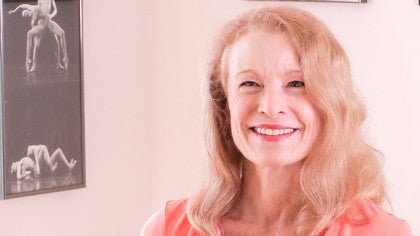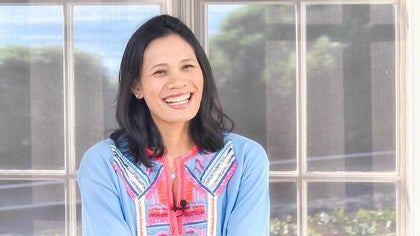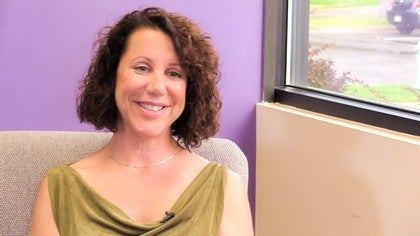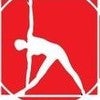Description
About This Video
Transcript
Read Full Transcript
I'm Jillian Hassell and we're in Beverly Hills at my tiny little studio. I downsized a few years ago to raise a family. So, uh, I'm going to talk about how I came to palazzos and met Kathy grant. I was a professional dancer and I danced first in Europe and then moved back to New York and was kind of working here and there. Not a steady job, but I had a job for a season with a company called Valley Hispanico of New York. I know I don't look the type, but uh, we were working with a lot of different techniques and styles. Uh, I had danced mainly neoclassical ballet, having trained at the school of American ballet and at the Hartman school and was pretty much a ballerina on point, but with belly Hispanica we were doing Spanish dance jazz.
And also we had a choreographed choreographer named Holly BT come to set a very modern Afro kind of style. And I was terrified to move because I have scoliosis and my back was extremely painful. So, uh, one of my fellow dancers, a gal named Mia Babylist, said, you should go to my gym. And my first thought was, Jim, I hate gym class. I never did well in gym class as a young student. But she kept saying, no, no, I have a back problem and she's really helped me and you should go to my gym.
So, uh, I kind of procrastinated, but then the season ended and I was on unemployment, which is what happens to dancers in America when they don't have a job. And, uh, I thought, well, my back's really pretty bad. I guess I better check this out. So I checked it out and it turned out to be Kathy grant in this tiny little studio at the top of, uh, band, Dell's department store, very Toni department store in mid Manhattan. And you went up this old creaky elevator with, uh, the, um, elevator operator and the, um, uh, Gates that had to open and closed and he used a lever and you got up there and you got off and you were in the middle of a hair salon, I believe. And you had to kind of go around the hair salon, past the snack bar area into this tiny little room at the very back near the bathroom. And that was Kathy grant. The year was 1981, I forgot to say, and I should say that I was dancing with a really painful back for many, many years.
I had fallen back when I was in Europe dancing with the ballet company in Geneva, Switzerland and seeing this really scary x-ray with my back just in a complete and uh, although I was in a terrible pain at the time, the doctor told me this isn't just from this fall and then was Al, you've had this condition for awhile. So I as a young dancer did, uh, injections of cortisone, osteopaths, reflexology, massage, anything you can think of, but kept dancing pretty much. And I think I was becoming more and more lopsided. So by the time I got to Cathy grant, I was a mess. And of course still dancing because dancers stance.
But my first impression of her was she was tiny and the studio was so small and no windows. And this odd looking, everyone always says it looks like a medieval torture chain. Her. But she had such an interesting eclectic group of people working out there. She had the very wealthy ladies with the perfect faces and quaffed hair that shopped at Bendel's and then she had modern dancers from way downtown. And I remember the a company, Don Redlich, there were a lot of dancers from there. And then she had dancers from Arthur Mitchell's a company as well, the dance theater of Harlem. And we were all mixed in together.
Matthew Broderick was about 14 years old and working out there because his mom found the place. So, uh, it was a very interesting mix and it was quite silent in there. That's a big difference I think from modern Pilati studios where there's a lot of talking. Uh, it was small space and she was very strict and not a lot of talking. I don't think I even knew it was [inaudible] when I first walked into Kathy's studio, remember me, I had said go to my gym and that's what it was called. It was called the gym. And although Kathy had her own operation, she was it within this larger, um, structure of Bendel's and she had certain, uh, bookkeeping things she had to do in line with the store and it was called the gym. So I don't remember it being called [inaudible] at all.
We never, it was body control ology. That's what Joe called it. Kathy didn't have a proper office at all. She had a little area with her telephone and probably an answering machine. And I remember the ladder barrel right next to it and she was the only teacher there for the most part. So I believe I stood there for a long time just watching, waiting for her to notice me. And I know that she noticed me, but she's so focused on what she was doing with whatever students she was with, that it took a long time. And I was a dancer, so I was used to waiting around and being quiet and watching and observing.
And um, I had to wait for her to have the moment to acknowledge me. And then I was sent to the girl's bathroom to change clothes because there was no changing area, no dressing room. She really had a very limited space, but it was intimidating, extremely intimidating. The most intimidating thing for me was I believe I was in terrible pain and uh, kind of masking it and pushing through. And Kathy in many ways was my last stop.
I had tried so many different modalities and scoliosis wasn't really well understood, uh, from a physiological point of view. And most people would look at my back, most doctors and say, you shouldn't be dancing at all. And of course you don't tell a young dancer to stop dancing. That was not even a thought for me. So I really put my total faith in Kathy, which I had to, and I always say she got me in alignment, which I wasn't.
I completely wasn't. And the interesting thing was years later after I was a success story, I wanted to get some continuing educational credits to complete my undergraduate degree at NYU. And I needed letters of recommendation. I asked her to write one for me and she wrote that. The thing about Kathy was, she was always bluntly honest too, to a painful point. And I had studied at the George Balanchine school and with the Hartness school and danced professionally for four years in Europe with Balanchine satellite companies. I'd met George Balanchine and worked with him and taking class with him and I'd met Martha Graham and I thought that's a pretty good pedigree.
She wrote this letter, I have to find it. It said so and so forth. When she'd met me, how long she worked with me. And also that my previous dance training before I got to her, she would evaluate as fair to good, fair to good. But she was right because I always say that my training as a dancer was very much monkey see, monkey do. You would watch the teacher and imitate with your own body, but there really wasn't the hands on guidance that we do in [inaudible].
And there was nobody who said, Hey, your hips are crooked and why does one leg turn out more than the other? And she was the first one who really broke things down. So I began to understand how my body worked and how to work with it. My first session with Kathy, she did a quick postural analysis and had me bend over and saw my curvatures and she said to me, I thought, Oh, I'm a dancer at monkey. See monkey do. I can do all these wonderful things. I think someone was doing the catwalk over on the Cadillac and I thought I can do that.
And I thought that I was going to be moving and very active and my whole first lesson was comprised of breathing into the concave side of my scoliosis and I had no idea what she was talking about. She said, just go home and practice breathing. And by the way, I don't know if I really have time to work with you. I'm going to have to look at my schedule and get back to you because I'm very busy and I just don't know. You're going to have to wait and see. Years later I had dinner with her up in San Francisco. We attended a conference together and it was the first time Kathy had gone on the road and I was so proud and I, I took her out to dinner and um, she said, you know, I really, when I first saw you, I didn't know what to do with you. And um, I was just done because I put my total faith in her and she always seemed to be in charge and know what she was doing. But she said when I first saw you, I never saw a back like that and I had no idea what to do. Now. She had told me that when I walked in the door in 1981 what would have happened.
So she really did have to clear out a special time for me and it turned out that I was getting there, I bet seven 30 in the morning and for a young dancer to get up that early and get to her place, I was, I was there with bells on and I thought I was doing a lot from myself, but of course then I found out that she lived in Brooklyn and she was taking two or three subways to get there to work with me for an hour before she opened her studio. So that was the dedication. I absolutely wanted to come back because she was fascinating and I thought if other people were able to do those wonderful exercises, that's what I wanted to be able to do. I wanted to find the way to do it and Kathy really educated me from the inside out, as we say, in Peloton, and it took a while. It took a while because she deconstructed me. The way that I say now when I teach teachers is it's like when we have a computer and the computer has a bug and it's not functioning correctly and we can't get rid of the bug.
So we take the computer to an expert and we wipe it clean, we save everything, but then we wipe the computer clean and then we reload the information in the proper order. And Cathy finally, after about a month of working with her two to three times a week, extremely intensively, and I would be there for hours because I, I worked through with her and then worked on my own and I had notes, I still have in the notes because everyone had to have their program and internalize it because she wasn't going to memorize your program for you. So, um, after about a month, she said, you know, I'm really frustrated because I get you in alignment and you look great. And then you go off and you go to dance class and you come back and you're a wreck again. She says you're going to have to stop dancing. And of course you tell a young dancer to stop dancing. And of course I'd heard I should not be dancing anyway. And I thought, wow, I can't believe it. But what she meant was because she was trying to raise that old muscle memory and the old computer program and put a new program on, I had to stay true to the new program for a time.
So I trusted her enough, trusted her enough to stop dancing for that complete summer and just work with her. And really, when I went back to dance class, it was with a whole new paradigm of how my body worked, what to do to equalize the right side and the left side and the top curve in the bottom curve. I had always to say, now when I look at a movement, I learn it twice. I learn it the way every other dancer would learn it and then I have to put it through the computer program again and go, okay. But for my body it's a little different. When I began with Kathy, she was one on one with me constantly hands on because I did not know where my center was. I didn't breathe correctly and she climbed all over my body.
There was one instance I'll never forget this, where I was lying face down and I have a high right shoulder and she wanted that upper trapezius to drop down and for me to access my mid traps and my lats to lift my arm. So I'm lying face down on the mat with a pillow under my forehead and the small boxes on either side of the, the flat mat and I was holding a tennis ball in my right hand and she had me begin lifting with my head facing the tennis ball. Then I had to do the same thing again with my head face down. Then I had to do the same thing again with my head facing away. Well, my old pattern was to hike the shoulder to lift the arm. The shorter, rotate it up and forward. And she became more and more frustrated. And she was sitting on me, holding me down, keeping this left rib that likes to pop out from popping out.
And she had both hands and both knees anchoring me and there wasn't anything. And my shoulder came up and she dug this sharp little chin. She used her chin and dug it down into my shoulder. She just wouldn't give up. And I remember years later at this dinner when I said, [inaudible] you were so patient with me. I just, I don't know what I would've done cause nobody, nobody had that kind of dedication to help me. But Kathy and she sat there and she said, I'm not patient. I'm stubborn.
Well the props had a very specific purpose in Kathy's studio because she wanted us to be independent. A lot of us were dancers. We were going on the road. And so what was very unique about Kathy studio at that time, no one else taught for her. I know later Cara research and you know, Kathy got older and didn't feel as well and began to feel like she had a, her son Malique she, she needed some time away. But when I started with Kathy in 81, nobody else really taught for her. So, and certainly she wasn't going to let anybody else work with me. The whole idea was to become independent. So from day one I had to have my notebook and my pen and take notes and I had a sequence and I had to write those notes to.
A lot of the time that I was spending there when she wasn't working with me was writing my notes out so that I better know my program. And uh, then she would teach dancers to help one another. So for instance, if you were going on tour with somebody, uh, someone else in your company would learn whatever your specific, she had knee people, she had back people, she had shoulder people, she had Nick people, she had feet people. And we all had our certain, uh, body conditioning and corrective exercise. We didn't call it rehab or therapy because obviously that was not her scope of practice, but it was so much more than a physical therapist because she understood dance and she understood what it meant to go through a [inaudible] in a relevant and how to push off and what the stresses were to land from a jump and the alignment issues so much better than any physical therapy possibly could. And so she taught us to teach one another a lot of times if she did not have the time, she'd say, Jillian, go teach someone else your exercise and spot them.
So in a way I was already learning to teach just by passing on what I had processed in my own body and that's how we worked. We worked with one another was also very small studio. I'll never forget her sitting people up on the high ladder barrel because that was the only place that she had that was high enough. And these were the her knee people before we had ultrasound or any of these sophisticated diagnostics that we have now, MRIs, this is many years ago. She would put her ear next to the person's knee, hold it as it was moving from flection to extension and back.
And we all know there's a little bit of rotation in the lower leg as the knee extends. It's not just a hinge joint. While she would make these minute little adjustments listening to the knee, and that's where she wanted the person to be doing the exercise. The thing that was so amazing, we talked about her listening to the knee. I remember her standing at her little area or maybe sitting on a stool doing her her books because she had to keep that up while everything else was going on with her back turned and saying, don't you do that to my machine? Don't you work the Springs like that? She could tell just by listening, going back to her ear, if someone was working correctly, she could tell because she just knew everything that was going on without even seeing it. She had that third eye in the back of her head.
And uh, that was also going back to why you ask about the props because there were not that many teachers. Basically her, um, we learned to use props instead of her hands. So in other words, if you were bowlegged you worked with balls or a tennis can wrapped in a, in a pad to, uh, train the alignment of your lower extremity as you were doing footwork. I had, um, a magic circle that I held while it was doing foot work to keep my rib from propping out my head. Did she called it the East Indian head isolation. That was the top part of my scoliosis. She would put a ball between my chin and I don't know this a bone, but just to keep my head in alignment, there were the prompts served a purpose to help us kind of like tying a string around your finger to remember to recruit the muscles properly.
It's just address how specific these exercises where I did a workshop where I, I taught Cathy's work and then wrote a little handbook to go with the video. It was actually Corolla and Kathy, but I would say, well, this is Kathy's rowing. For years I would go out and teach at conferences or workshops. Let me teach you Kathy Grant's rowing. And at that dinner I went to with her years later where she said that she didn't know what to do with me when she first saw me. Um, she said, well, you know, one thing bothers me.
You're teaching this rowing and you're saying it's mine and my heart is falling down out of my chest. And I'm thinking, well, I always want to give credit. You know, if I learned it from you or a Corolla or Ron or someone else, I always want to give credit. And she says, but it's not mine. She said, it's you or it's yours. And I sat there and digested that and went home and thought about it and I thought, my God, the implications of this are astounding. If it was my rowing, apparently when she taught it in her studio, she called it Jillian's rowing means that she was creating a specific version of each exercise for the person who was right in front of her. It wasn't by wrote, it wasn't, this is the way Joe taught it, so I have to teach you this way. If it didn't work, she would remake it for that person. She changed me on such a level.
The first thing was dancers always carried down in his bags and we didn't have backpacks back then. In 1981 we had big heavy dance bags. Well, that was done with when she said, you have a high road shoulder, you can't carry a bag. It's gotta be a backpack. Find one. And then it was, how would I stand? One day I was waiting to pay her and she had just spent a long time getting me in alignment and I was standing, shifted into one hip with the other leg in front, the way a dancer kind of cocked their hip or a model and she said, don't you stand like that. I just spent all this time on you and you're throwing it away. Don't you dare stand like that. And I began riding the subway with my backpack and balancing and I, I couldn't even go to sleep without thinking about my alignment.
That was the level that she affected me. And she always said, what's the point of being in alignment for an hour twice a week or three times a week? And then throwing it all away. It has to integrate into your lifestyle. This is my original notebook from Kathy Grant's, um, studio. And apparently it was off by a year. I went in 1980 not 81, so dial that back. So I have the address, which was a West 57th street between fifth and sixth Avenue and the phone number, sixth floor gym. And the um, first exercise she gave me, well actually the first lesson was just breathing, but Cathy is incredible. She is so giving today, I was there for two and a half hours longer even than yesterday. I think she helps so many people simultaneously.
It's incredible that she can keep everyone's individual problems straightened her head. I bought a card for 10 sessions today because it's cheaper that way. I'm grateful she can make time for me. I'm really lucky. Exclamation point. Here's the date entry date in my little notebook. Eight 14, 1980, so 33 years ago today. Um, machine exercises. Now, this is interesting cause she called them the machine and usually Corolla would never do that. She wanted it to be called the apparatus. But Kathy wrote, it's called the machines. So this was an exciting day for me apparently because I was doing not specific therapy. In other words, I was learning actual reform or work as a suppose to therapy as opposed to therapy for me. But here's an exercise that's not done very often.
It's a spine lift, feet in the straps, headpiece, flat foot piece, flat using the abdominals, only arms inside the knees. Embryonic position, hands holding loosely onto the chords. She used courts, not straps. Um, but the arms did not do anything. Lifting with knees bent up to a shoulders stand, one spring only. So that was for me to learn on the reformer, how to segment from the tailbone up and dropping back down.
But with my curve, it was kind of like a, a meandering river. I had to really focus depending on what level of my spine. So there's a lot of notes about that. Went down to arm circles. I had the salute, uh, which she called temp alarms, the temples, she called temp alarms. Um, here's an interesting note, third gear, because a lot of the Pilati is, uh, uh, apparatus. Now the reformers don't even have gears. We've got all these fancy, um, different ways of adjusting spring resistance and variable spring resistance. But we used gears because all the Springs were more or less the same, uh, resistance. That was the 14th of August in 1980.
I was adding onto my program. What would I want to see preserved of Kathy? I think, um, her precision and her determination to inspire people. You know, you'd get down sometimes. And uh, I remember in later years, even when she was, uh, traveling and seeing many, many, many more students because she was working at Tisch at NYU and traveling to conferences and it was just that she, I thought she was patient, but she said, no, I'm stubborn. And she never, ever, ever gave up. And she just loved teaching. And I'll never forget, I was in Denver, and this is the year, it was a [inaudible]. He's on tour. And this was the year that she was very ill. she flew to Denver, she didn't have the right meds, she was noncompliant taking the meds, she was at altitude.
And I had never seen a black woman turn green and ashen, but she was so ill and she still was walking around. And I was teaching a Cadillac workshop and I had a lot of students. And she walked in and she was gonna watch me teach. She had a about her and her hunger always to learn. And there she was, my mentor and I was teaching and I, I was of course, extremely nervous and I know she felt so ill and there she was watching and learning and the workshop ended and everyone went off to lunch.
And I went up to her and she said, well now Gillian. And she looked terrible by the way. She said, Julian, have you ever done the monkey on the Cadillac with no spring? And I said, no, no, because in the interim, when I had moved to California, she was still inventing of course. And she said, well, let me teach it to you. And she did. And it was extremely difficult. Um, and then she went out and they took her to the hospital right after that.
So the last thing that she did before they took her off to the hospital and she was in the hospital for weeks, she almost died, was teach me something new.
Pilates Legacy Project: Discussions
Comments
You need to be a subscriber to post a comment.
Please Log In or Create an Account to start your free trial.























